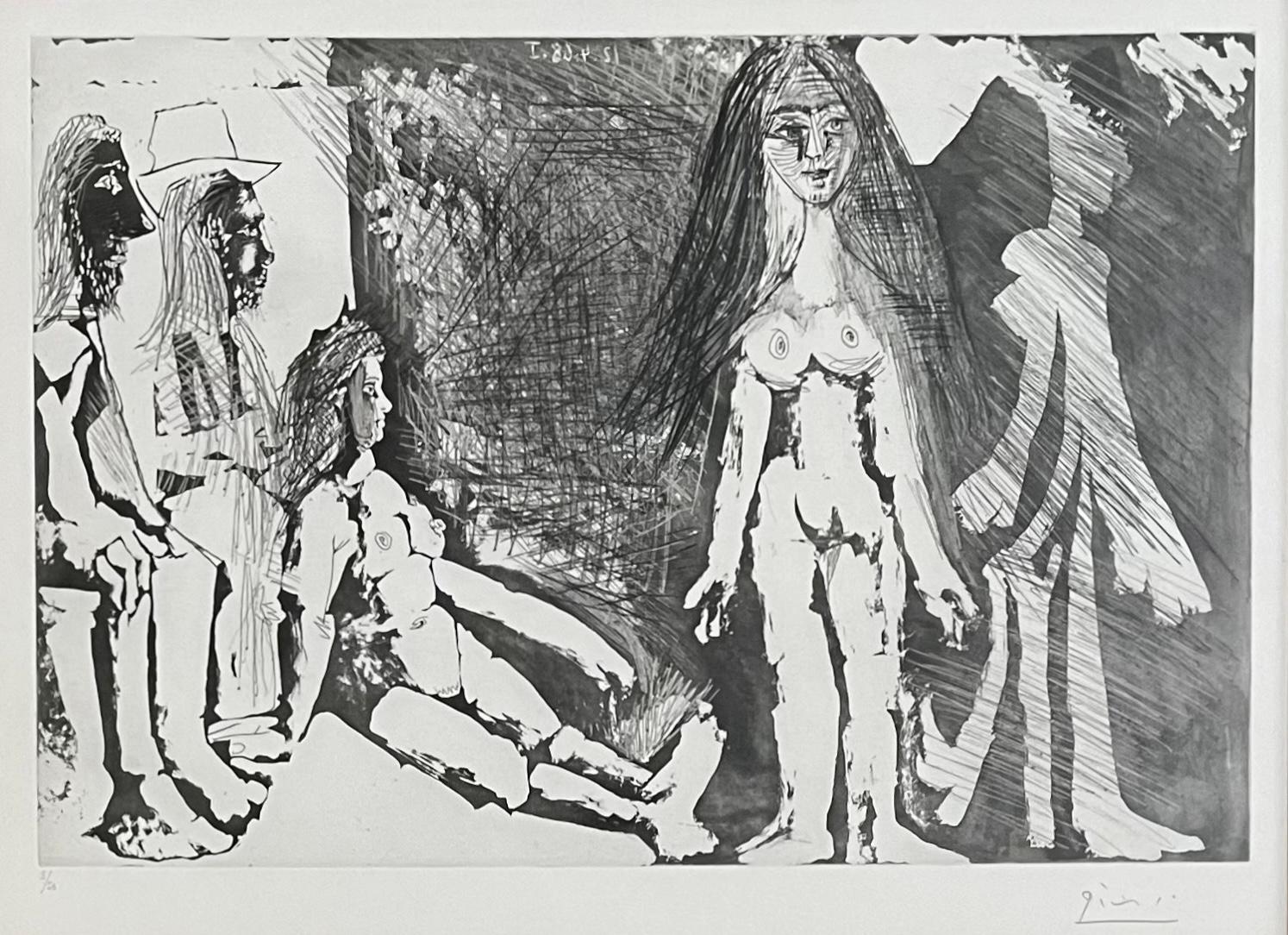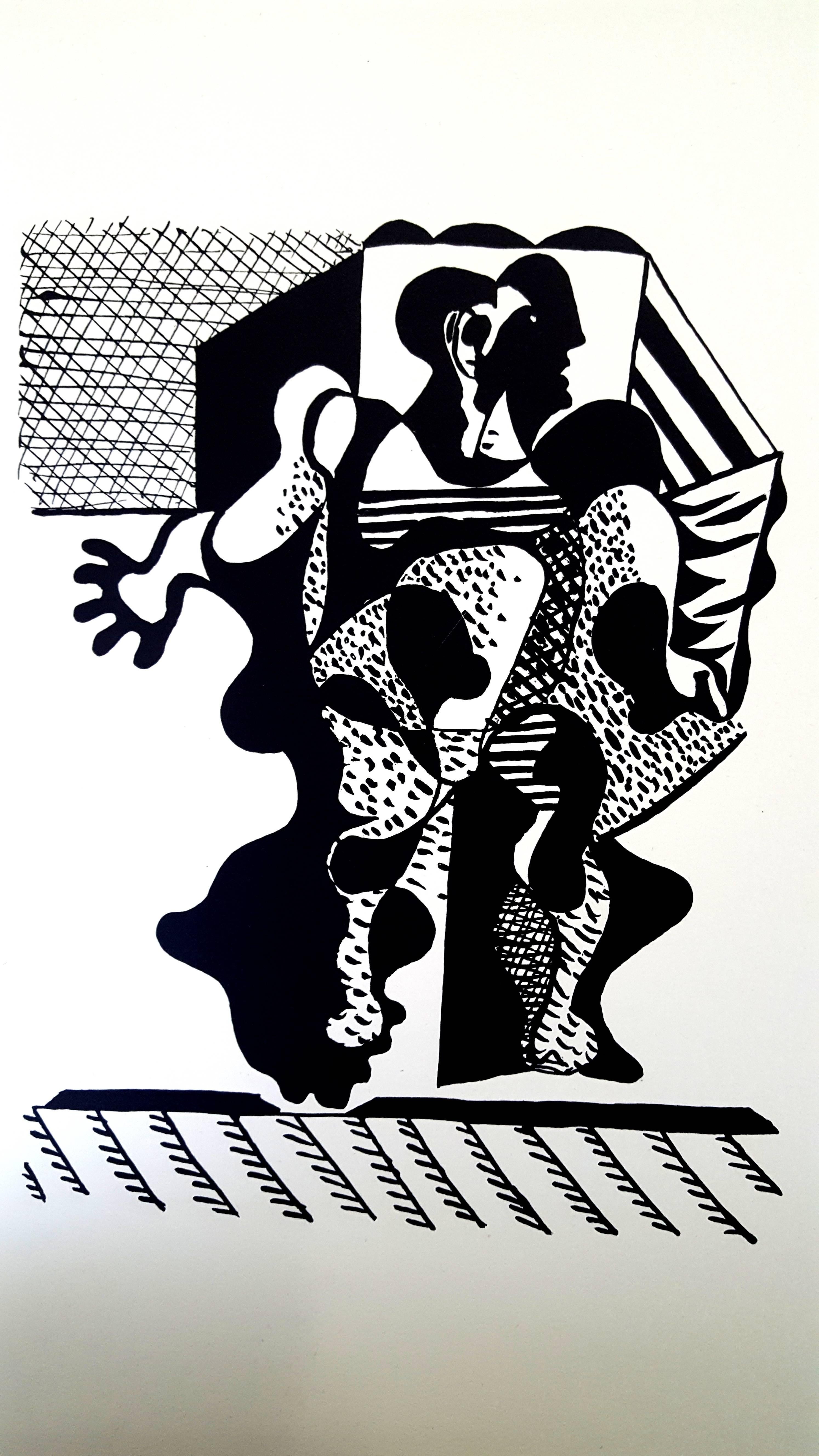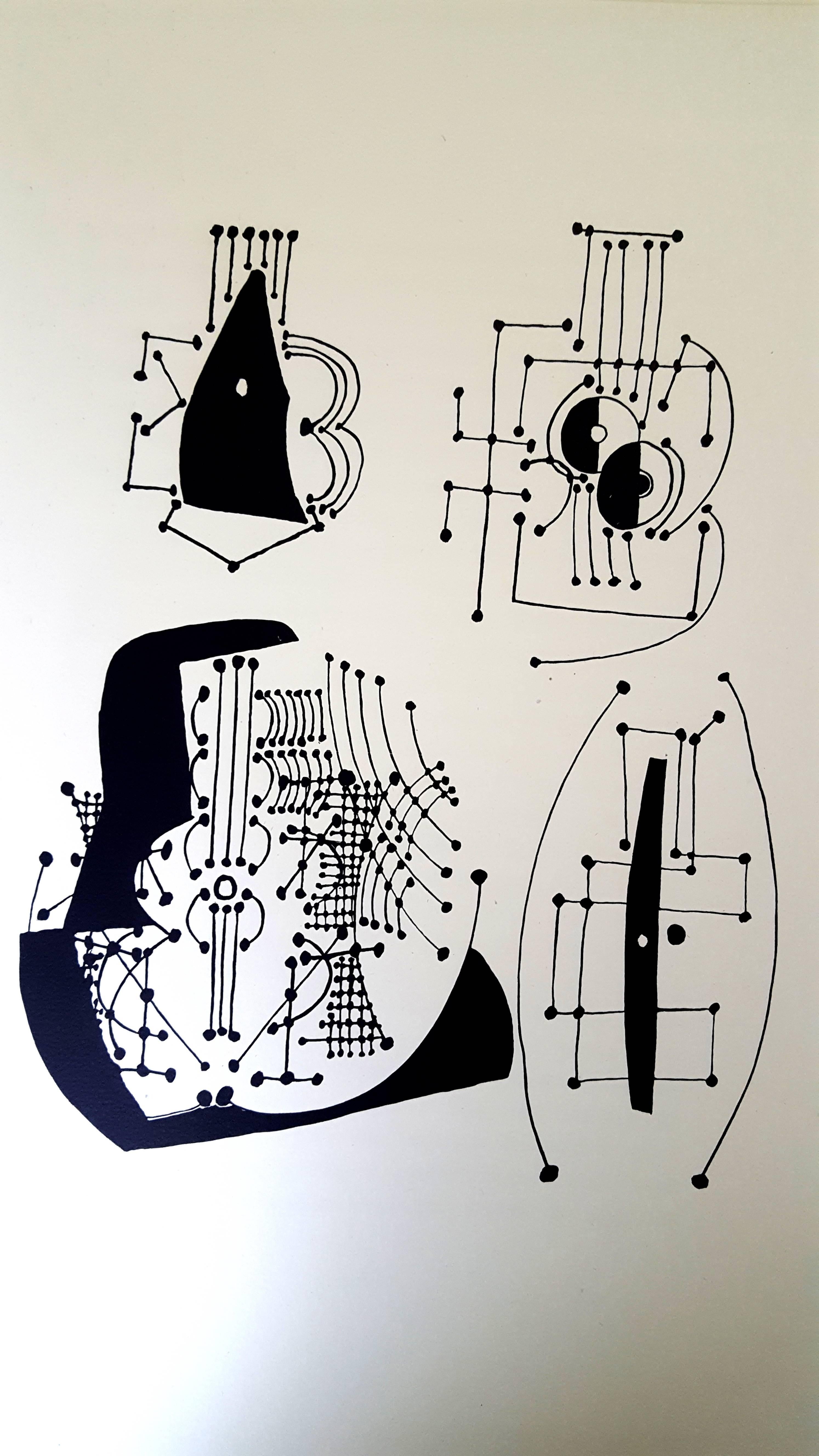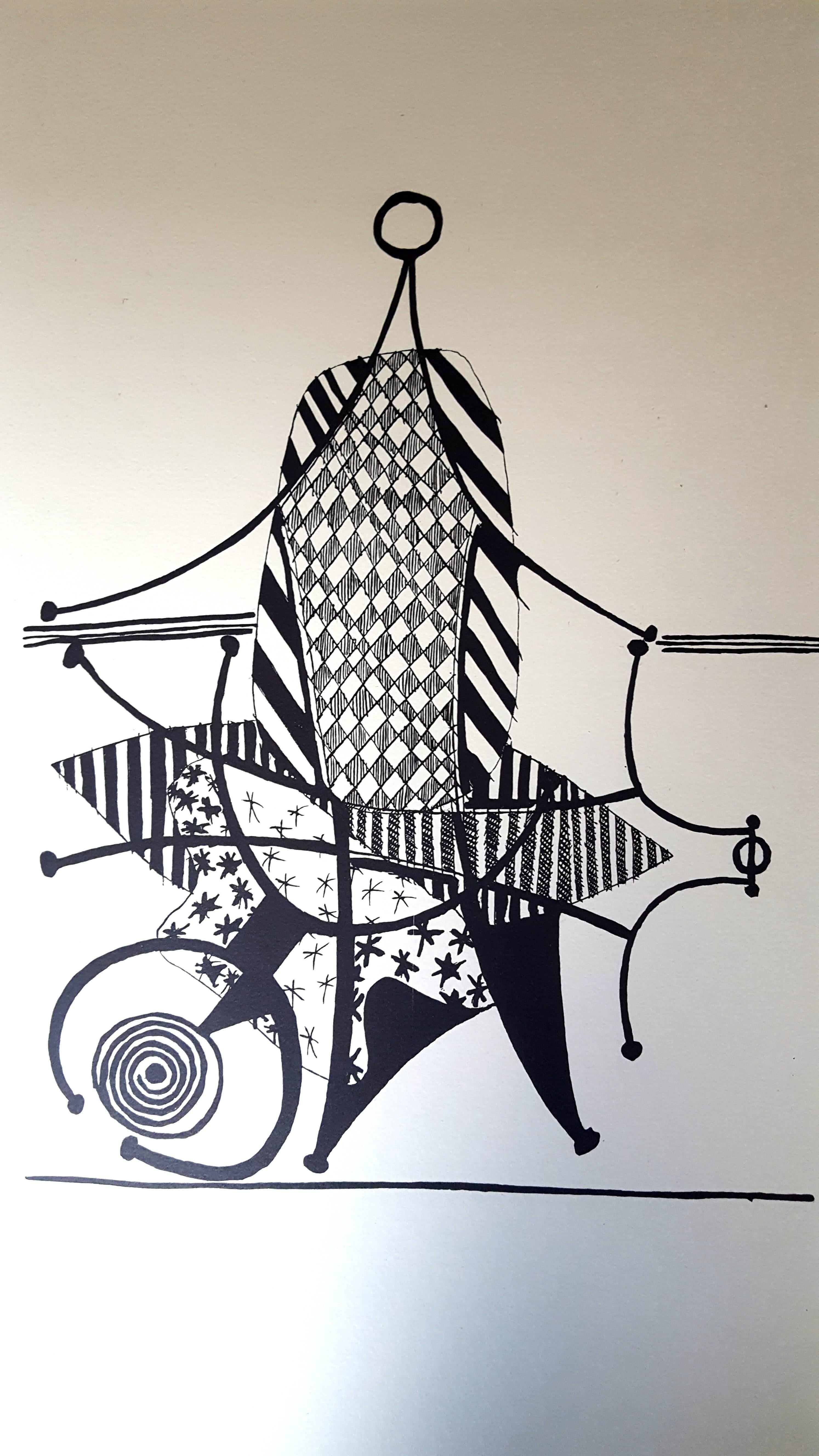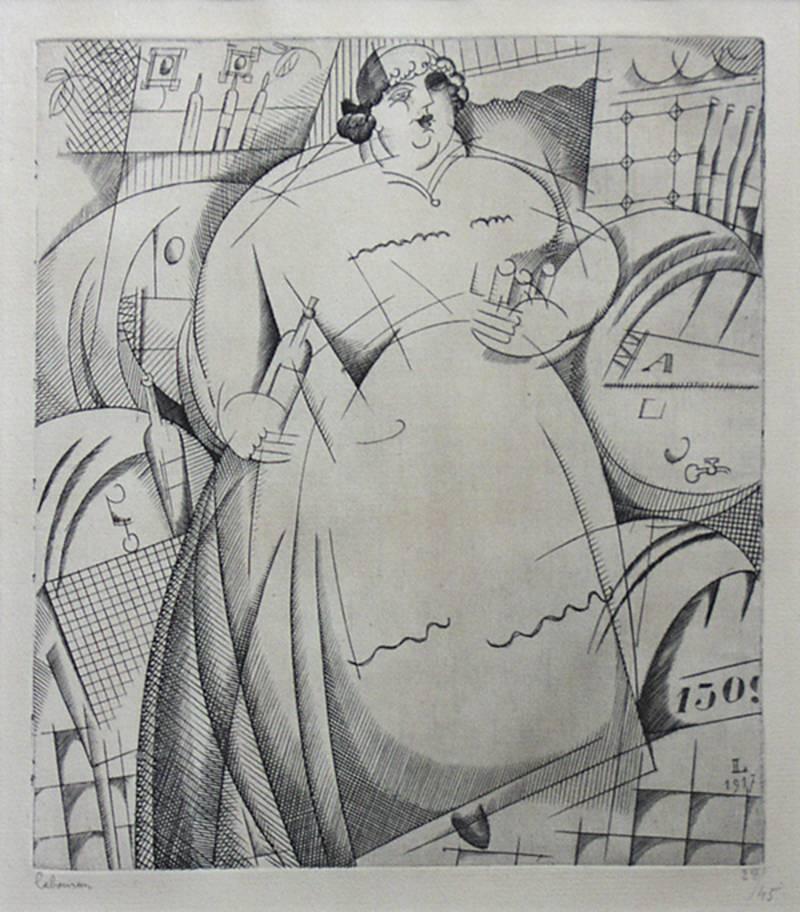Items Similar to La Receveuse (Bill Collector) —French Cubism
Want more images or videos?
Request additional images or videos from the seller
1 of 3
Jean-Emile LaboureurLa Receveuse (Bill Collector) —French Cubism1919
1919
About the Item
Jean-Emile Laboureur, 'La Receveuse', engraving, 1919, edition 8, first state of two (artist's proof). Laboureur, Godefroy 190.
Signed and numbered '3/8 ép' in pencil. Initialed and dated '1918' in the plate. A fine impression, on cream laid paper, with full margins (1 1/4 to 1 1/2 inches), in excellent condition. Very Scarce in this state. Matted to museum standards, unframed.
ABOUT THE ARTIST
Born in Nantes in the summer of 1877, Emile Laboureur was the son of a prosperous bourgeois family. He went to Paris in 1895 to study law but found himself more often drawn to study at the famed art school Académie Julian, although he never officially enrolled there. Upon his introduction to the distinguished wood engraver Auguste Lepère, he decided to take up the formal study of printmaking.
Lepère’s technical instruction in the craft of printmaking was essential for Laboureur’s artistic initiation but provided little in the way of stylistic inspiration. It was Toulouse-Lautrec, with whom Laboureur had become socially acquainted in 1896, who liberated his sense of humor and allowed him to recognize the potentialities for the visual expression of wit and irony. Laboureur assimilated his own orthodox wood engraving and etching techniques with the convivial, cosmopolitan subject matter of Lautrec’s color lithographs. Concurrently, his work took increasing cognizance of other contemporary innovations: the baleful hallucinations of Odilon Redon; the serpentine curves and wry social observations of Pierre Bonnard; and, most importantly, the incisive black and white compositions of Félix Vallotton, whose influence stayed with Laboureur’s graphic works for twenty years.
By 1899, Laboureur had fulfilled his compulsory service with the military, which he despised, and was able to pursue his love of art full-time. Laboureur traveled extensively to study, work, and learn all there was about the history of engraving. He developed a vast knowledge and connoisseurship during his trips to Italy, Germany, and throughout Europe.
Laboureur traveled to the United States in 1903—the country and its people appealed to him enormously. He was intrigued by the frenzy of the great industrial capitals, by the spectacle of skyscrapers, by the conspicuous consumption of the monied classes, and equally by the urban proletariat. Among the cities he visited were Albany, Boston, New York, Newark, Philadelphia, and Pittsburgh. Pittsburgh captured his imagination and he produced two successful series based on the city – 'Ten Etchings from Pittsburgh' (1905) and 'In The Pittsburgh Mills' (1906). He would lecture wherever he went, especially in New York, under the name Jean-Emile.
Having stayed in London for a period, he finally settled in France for good by 1910. By that time analytical cubism had burst upon the art scene. Laboureur’s style, however, remained essentially unchanged for the next several years while he was digesting this new genre. By 1913, he began to invent a cubist vernacular that was distinctly his own, one that would rival Picasso, Villon, and Braque but one which was distinctly decorative rather than analytical.
With the outbreak of World War I, Laboureur was again enlisted in the military. This disruption to his artistic life necessitated a change in mediums. No longer able to produce etchings due to the bulky paraphernalia required for acid baths, he began to engrave his plates (which he often salvaged from an ammunition depot) directly with a portable burin. In 1916, he produced thirty-one engravings, among which was a series of nine published as ‘Petites images de la guerre sur le front britannique’. Their subject matter eschews the horror of war to focus on the absurd and comic aspects of the tragedy which engulfed Europe.
After the war, Laboureur turned increasingly to book illustration. He bought a house on the Breton coast and transformed himself from a bachelor bon-viveur into a country family man with two sons. He worked steadily during the 1920s, but due to the worldwide depression of the 1930s, his output began to lessen until 1939 when he was struck down by a disease that left him paralyzed and unable to work. His last two prints remain unfinished. He died in 1943.
Edited from: Robert Allen, ‘Jean-Emile Laboureur: A Centenary Tribute,’ Alliance Française, New York, 1977.
- Creator:Jean-Emile Laboureur (1877-1943, French)
- Creation Year:1919
- Dimensions:Height: 7.75 in (19.69 cm)Width: 5.82 in (14.79 cm)
- Medium:
- Movement & Style:
- Period:
- Condition:
- Gallery Location:Myrtle Beach, SC
- Reference Number:
About the Seller
5.0
Recognized Seller
These prestigious sellers are industry leaders and represent the highest echelon for item quality and design.
Platinum Seller
These expertly vetted sellers are 1stDibs' most experienced sellers and are rated highest by our customers.
Established in 1995
1stDibs seller since 2016
254 sales on 1stDibs
Typical response time: 2 hours
Associations
International Fine Print Dealers Association
- ShippingRetrieving quote...Ships From: Myrtle Beach, SC
- Return PolicyA return for this item may be initiated within 7 days of delivery.
More From This SellerView All
- 'Le Tir Forain' (Fairground Shooting) — 1920s French CubismBy Jean-Emile LaboureurLocated in Myrtle Beach, SCLe Tir Forain, engraving, edition 108, 1920-21, Sylvain Laboureur 191. Signed and numbered '19/85 ép' in pencil. Initialed 'L' and dated 1920 in the matrix, upper right. A superb, ri...Category
1920s Cubist Figurative Prints
MaterialsEngraving
- 'La Danse' (Dance) — French Cubist WoodcutBy Raoul DufyLocated in Myrtle Beach, SCRaoul Dufy, 'La Danse' (Dance), woodcut, 1910. A proof impression before the second edition of 220 in 1953; with the estate stamp 'ATELIER RAOUL DUFY' in the lower right margin; the blind stamp 'GG' in the lower left sheet corner. Annotated 'E/Z' in pencil, beneath the estate stamp; and 'bois original' in the margin, lower left. Titled in the block, lower right. A superb, richly-inked impression, on heavy, cream wove paper; the full sheet with wide margins (3 1/2 to 6 3/4 inches); slight toning at the bottom and right sheet edges, well away from the image, otherwise in excellent condition. Archivally sleeved, unmatted. Image size 12 5/16 x 12 1/2 inches (313 x 318 mm); sheet size 19 3/4 x 25 3/4 inches (502 x 654 mm). Collections: Art Gallery of New South Wales (Australia), Brooklyn Museum, Cleveland Art Museum, Fine Arts Museums of San Francisco, Minneapolis Institute of Art, Museum of Fine Arts, Boston, The Nelson-Atkins Museum of Art, Nasher Museum of Art (Duke University), Toledo Art Museum. From the suite of four woodcuts entitled 'Les Plaisirs de la Paix' (The Pleasures of Peace), published by Éditions de La Sirène, Paris in 1926. The other three works in the series are 'La Peche' (Fishing), 'La Chase' (The Hunt), and 'L'amore' (Love). See our other listings for 'La Peche' and 'L'amore'. Collections: Brooklyn Museum, Art Gallery of New South Wales, Cleveland Museum of Art, Dallas Museum of Art, Fine Arts Museums of San Francisco, Minneapolis Art...Category
1910s Cubist Figurative Prints
MaterialsWoodcut
- 'La Pêche' (Fishing) — French Cubist WoodcutBy Raoul DufyLocated in Myrtle Beach, SCRaoul Dufy, 'La Pêche' (Fishing), woodcut, 1910, from the second edition of 220 printed in 1953. With the estate stamp 'ATELIER RAOUL DUFY' in the lower left margin. Numbered '106/220' in pencil, lower right. Titled in the block, lower right. A superb, richly-inked impression, on heavy, cream wove paper, the full sheet with wide margins (3 to 5 inches), slight toning at the sheet edges, well away from the image; otherwise in excellent condition. Archivally sleeved, unmatted. Image size 12 1/2 x 15 13/16 inches (318 x 402 mm); sheet size 19 9/16 x 25 3/4 inches (497 x 654 mm). From the suite of four woodcuts entitled 'Les Plaisirs de la Paix' (The Pleasures of Peace), originally published by Éditions de La Sirène, Paris in 1926. The other three works in the series are 'La Danse' (The Dance), 'La Chase' (The Hunt), and 'L'amore' (Love). See our other listings for 'La Danse' and 'L'amore'. Collections: Cleveland Museum of Art, Minneapolis Art...Category
1910s Cubist Figurative Prints
MaterialsWoodcut
- 'Cargo Carriers' — 1930s New York HarborBy Otto KuhlerLocated in Myrtle Beach, SCOtto Kuhler, 'Cargo Carriers', etching and drypoint, c. 1932, edition 10, Kennedy 44. Signed in pencil. A superb, atmospheric impression with rich burr and selectively wiped overall plate tone, in dark brown ink, on Arches cream laid paper; wide margins (2 to 2 3/4 inches), in very good condition. Printed by the artist. Original Kennedy Galleries mat and label. Scarce. "On my trips up and down N.Y. harbor on the Weehawken Ferry, the late evening sun playing on the side of the big liners has always intrigued me... The liner shown I believe to be the Vaterland of the North German Lloyd...Category
1930s American Modern Figurative Prints
MaterialsEtching, Drypoint
- 'Mother of All' – Mid-Century Surrealism, Atelier 17Located in Myrtle Beach, SCIan Hugo, 'Mother of All', engraving, 1945, edition 50. Signed, dated, titled, and numbered '48/50' in pencil. With the blind stamp 'madeleine-claude jobrack...Category
1940s Surrealist Figurative Prints
MaterialsEngraving
- Arbre-Homme (Tree-Man) —Mid-Century SurrealismBy Ferdinand SpringerLocated in Myrtle Beach, SCFerdinand Springer, 'Arbre-Homme', engraving, 1945, edition 23. Signed and numbered '23/20' in pencil. A fine, richly-inked impression, on heavy, b...Category
1940s Surrealist Figurative Prints
MaterialsEngraving
You May Also Like
- 347 Series (B. 1511; Ba. 1527), Pablo PicassoBy Pablo PicassoLocated in Fairfield, CTArtist: Pablo Picasso (1881-1973) Title: Jeune fille regardée par une vielle femme et deux hommes dont un gitan Year: 1968 Medium: Etching, aquatint and drypoint on Rives BFK paper Size: 12.5 x 18.5 (plate); 17.75 x 24.25 inches (paper); 20.25 x 30.25 inches (frame) Condition: Excellent Catalogue: B. 1511; Ba. 1527 Inscription: Signed and numbered in pencil Notes: Published by Galerie Louise Leiris, Paris, from the 347 Series. PABLO PICASSO (1881-1973) Spanish painter and sculptor is one of the most recognized figures of twentieth century art. During his artistic career, which lasted more than 75 years, he created thousands of works using all kinds of mediums. He changed art more profoundly than any other artist of his time. First famous for pioneering cubism, Picasso continued to develop his art with a pace and vitality comparable to the accelerated technological and cultural changes of the twentieth century. Each change embodied a radical idea, and might be said that Picasso lived several artistic lifetimes. ABOUT SELLER DO YOU HAVE ARTWORK TO SELL? WE ARE ACTIVELY SEEKING CONSIGNMENTS AND EXCEPTIONAL OBJECTS TO PURCHASE OUTRIGHT! Art Commerce...Category
1960s Cubist Nude Prints
MaterialsAquatint, Etching, Drypoint
- Pablo Picasso (after) Helene Chez Archimede - Wood EngravingBy (after) Pablo PicassoLocated in Collonge Bellerive, Geneve, CHPablo Picasso (after) Helene Chez Archimede Medium: engraved on wood by Georges Aubert Dimensions: 44 x 33 cm Portfolio: Helen Chez Archimede Year: 1955 Edition: 240 (Here it is on...Category
1950s Cubist Figurative Prints
MaterialsEngraving, Woodcut
- Pablo Picasso (after) Helene Chez Archimede - Wood EngravingBy (after) Pablo PicassoLocated in Collonge Bellerive, Geneve, CHPablo Picasso (after) Helene Chez Archimede Medium: engraved on wood by Georges Aubert Dimensions: 44 x 33 cm Portfolio: Helen Chez Archimede Year: 1955 Edition: 240 (Here it is on...Category
1950s Cubist Figurative Prints
MaterialsEngraving, Woodcut
- Pablo Picasso (after) Helene Chez Archimede - Wood EngravingBy (after) Pablo PicassoLocated in Collonge Bellerive, Geneve, CHPablo Picasso (after) Helene Chez Archimede Medium: engraved on wood by Georges Aubert Dimensions: 44 x 33 cm Portfolio: Helen Chez Archimede Year: 1955 Edition: 240 (Here it is on...Category
1950s Cubist Figurative Prints
MaterialsEngraving
- Pablo Picasso (after) Helene Chez Archimede - Wood EngravingBy (after) Pablo PicassoLocated in Collonge Bellerive, Geneve, CHPablo Picasso (after) Helene Chez Archimede Medium: engraved on wood by Georges Aubert Dimensions: 44 x 33 cm Portfolio: Helen Chez Archimede Year: 1955 Edition: 240 (Here it is on...Category
1950s Cubist Figurative Prints
MaterialsEngraving
- La Cabaretiere obese (The Fat Tavern Keeper)By Jean-Emile LaboureurLocated in New York, NY1917. (Godefroy 172, II/II). Engraving on Rives. Signed with initial and dated on the plate, l.r "L 1917". Signed in pencil and numbered 28/45. Framed Stein, The Cubist Print p. 14...Category
1910s Cubist Figurative Prints
MaterialsEngraving
